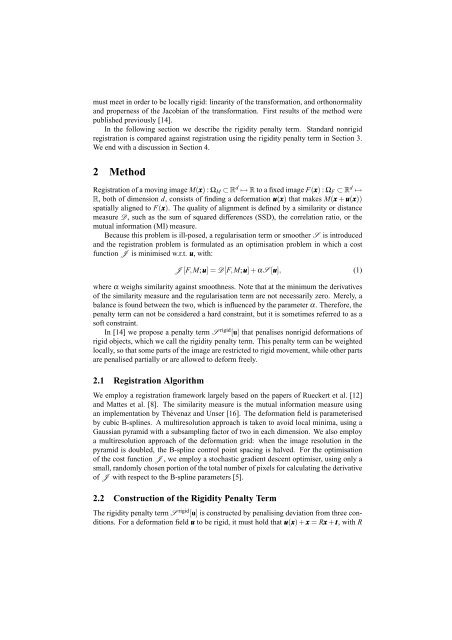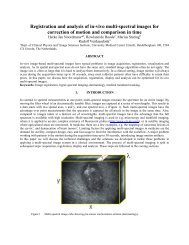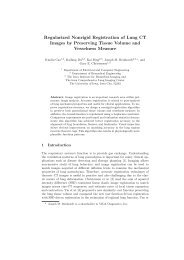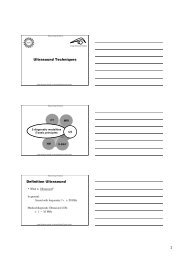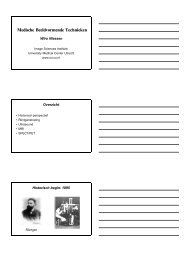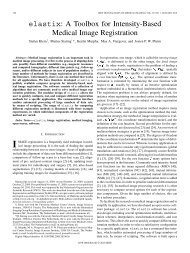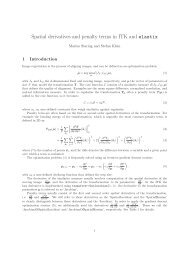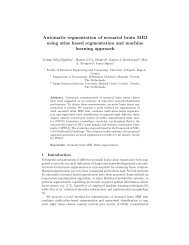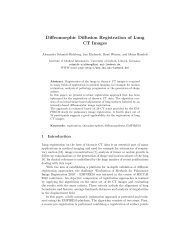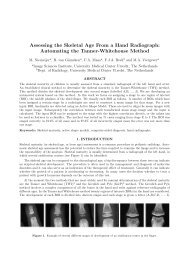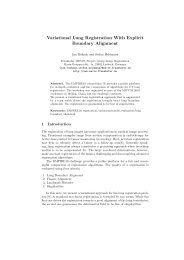Evaluation of a Rigidity Penalty Term for Nonrigid Registration - elastix
Evaluation of a Rigidity Penalty Term for Nonrigid Registration - elastix
Evaluation of a Rigidity Penalty Term for Nonrigid Registration - elastix
You also want an ePaper? Increase the reach of your titles
YUMPU automatically turns print PDFs into web optimized ePapers that Google loves.
must meet in order to be locally rigid: linearity <strong>of</strong> the trans<strong>for</strong>mation, and orthonormality<br />
and properness <strong>of</strong> the Jacobian <strong>of</strong> the trans<strong>for</strong>mation. First results <strong>of</strong> the method were<br />
published previously [14].<br />
In the following section we describe the rigidity penalty term. Standard nonrigid<br />
registration is compared against registration using the rigidity penalty term in Section 3.<br />
We end with a discussion in Section 4.<br />
2 Method<br />
<strong>Registration</strong> <strong>of</strong> a moving image M(x) : Ω M ⊂ R d ↦→ R to a fixed image F(x) : Ω F ⊂ R d ↦→<br />
R, both <strong>of</strong> dimension d, consists <strong>of</strong> finding a de<strong>for</strong>mation u(x) that makes M(x + u(x))<br />
spatially aligned to F(x). The quality <strong>of</strong> alignment is defined by a similarity or distance<br />
measure D, such as the sum <strong>of</strong> squared differences (SSD), the correlation ratio, or the<br />
mutual in<strong>for</strong>mation (MI) measure.<br />
Because this problem is ill-posed, a regularisation term or smoother S is introduced<br />
and the registration problem is <strong>for</strong>mulated as an optimisation problem in which a cost<br />
function J is minimised w.r.t. u, with:<br />
J [F,M; u]=D[F,M; u]+αS [u], (1)<br />
where α weighs similarity against smoothness. Note that at the minimum the derivatives<br />
<strong>of</strong> the similarity measure and the regularisation term are not necessarily zero. Merely, a<br />
balance is found between the two, which is influenced by the parameter α. There<strong>for</strong>e, the<br />
penalty term can not be considered a hard constraint, but it is sometimes referred to as a<br />
s<strong>of</strong>t constraint.<br />
In [14] we propose a penalty term S rigid [u] that penalises nonrigid de<strong>for</strong>mations <strong>of</strong><br />
rigid objects, which we call the rigidity penalty term. This penalty term can be weighted<br />
locally, so that some parts <strong>of</strong> the image are restricted to rigid movement, while other parts<br />
are penalised partially or are allowed to de<strong>for</strong>m freely.<br />
2.1 <strong>Registration</strong> Algorithm<br />
We employ a registration framework largely based on the papers <strong>of</strong> Rueckert et al. [12]<br />
and Mattes et al. [8]. The similarity measure is the mutual in<strong>for</strong>mation measure using<br />
an implementation by Thévenaz and Unser [16]. The de<strong>for</strong>mation field is parameterised<br />
by cubic B-splines. A multiresolution approach is taken to avoid local minima, using a<br />
Gaussian pyramid with a subsampling factor <strong>of</strong> two in each dimension. We also employ<br />
a multiresolution approach <strong>of</strong> the de<strong>for</strong>mation grid: when the image resolution in the<br />
pyramid is doubled, the B-spline control point spacing is halved. For the optimisation<br />
<strong>of</strong> the cost function J , we employ a stochastic gradient descent optimiser, using only a<br />
small, randomly chosen portion <strong>of</strong> the total number <strong>of</strong> pixels <strong>for</strong> calculating the derivative<br />
<strong>of</strong> J with respect to the B-spline parameters [5].<br />
2.2 Construction <strong>of</strong> the <strong>Rigidity</strong> <strong>Penalty</strong> <strong>Term</strong><br />
The rigidity penalty term S rigid [u] is constructed by penalising deviation from three conditions.<br />
For a de<strong>for</strong>mation field u to be rigid, it must hold that u(x)+x = Rx + t, with R


